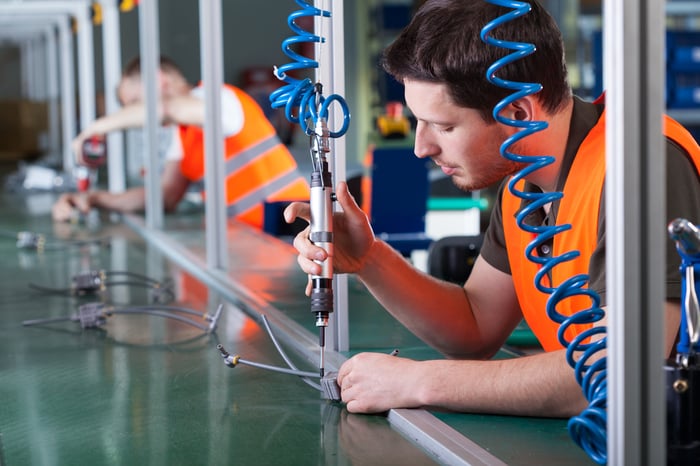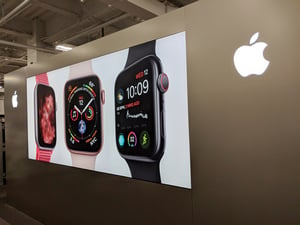
Many small manufacturers get their start innovating around a single hit product but building on early success is often the hardest thing for a business to do. As Robert Glazer explains, “When you bet your company's future on just one product's explosive success, that doesn't automatically translate to long-term growth.”
The most successful manufacturers understand that resting on success can kill even the most popular businesses. A commitment to ongoing product development is the best way to ensure future relevancy. Developing additional products that align with a current area of expertise is crucial to building the brand and driving growth.
Figuring out how to expand with a new product that plays in the same space where they have already built a customer base is the key to sustainability. However, many inventors-turned-business owners find this step insurmountable, allowing success to slip away once a product’s heyday has ended.
The most effective way to find the next hit product and foster sustainable growth is to:
1. Be Forward-Looking
In manufacturing staying a step ahead means innovating for the future instead of creating products for today. Businesses must aim to solve customers’ future problems instead of just providing a solution for today’s pain points. Offerings should align with the company’s core values even as the market continues to evolve. Furthermore, strategic decision-making should always tie back to these values.
Documenting a vision for the future and measuring progress against that vision is a key step toward moving the business forward. Employees at all levels should adopt this vision and be committed to achieving it through their own efforts.
 Apple is a great example of a forward-looking company. A $150 million loan from Microsoft brought Apple back from the brink of failure in 1997, giving them the capital needed to expand out of the computer industry. After launching the widely popular iPod, they dove deep into music space, expanding product and service offerings before getting into cell phones, wearable technology, and other lucrative verticals. Apple knew that while personal computers were going to continue to change, consumers were going to have other not-yet-recognized technology needs to fuel their media and entertainment consumption. Instead of staying on the somewhat profitable computer bandwagon, they developed new technology to accelerate the market forward into areas where the profit margins could be much higher. Their forward-focused innovation has earned them top market share and a reputation as the sixth most loved brand in the world.
Apple is a great example of a forward-looking company. A $150 million loan from Microsoft brought Apple back from the brink of failure in 1997, giving them the capital needed to expand out of the computer industry. After launching the widely popular iPod, they dove deep into music space, expanding product and service offerings before getting into cell phones, wearable technology, and other lucrative verticals. Apple knew that while personal computers were going to continue to change, consumers were going to have other not-yet-recognized technology needs to fuel their media and entertainment consumption. Instead of staying on the somewhat profitable computer bandwagon, they developed new technology to accelerate the market forward into areas where the profit margins could be much higher. Their forward-focused innovation has earned them top market share and a reputation as the sixth most loved brand in the world.
2. Continue Investing in R&D
Demand is always highest when a product is new, but it cannot stay that strong forever. The Founder and CEO of Acceleration Partners explain it best when he says, “Hot products can lead to unwise financial decisions. Riding the wave of a single product's success too far and too fast can result in excess inventory or unsustainable infrastructure expansion.” This problem can be compounded when businesses invest in their most popular (or only) product at the expense of research and development. Committing a percentage of the budget to R&D ensures that funds and personnel will always be dedicated to innovation.
R&D should be focused on creating new products, not just iterations of the same hit product, to maintain relevancy even as the market evolves and the competitive landscape changes. As a general rule, approximately 25% of revenue each year should come from new products to achieve sustainable growth.
3. Be Authentic
 In the push to develop new products, some organizations get caught up in the “us too” trap. The result is new offerings that simply replicate what is already being offered by competitors instead of products that move the industry forward. This is an unprofitable path that can lead even the best business astray. Instead, product offerings should exude authenticity, leveraging a company’s existing authority in a way that is unique. Consumers should know what the business stands for, not just what it sells.
In the push to develop new products, some organizations get caught up in the “us too” trap. The result is new offerings that simply replicate what is already being offered by competitors instead of products that move the industry forward. This is an unprofitable path that can lead even the best business astray. Instead, product offerings should exude authenticity, leveraging a company’s existing authority in a way that is unique. Consumers should know what the business stands for, not just what it sells.
Anker is a manufacturer that has done this to perfection! The company started from a simple desire to make the tech products consumers need for less. Making affordable technology more accessible meant competing against big brands with well-established distribution channels. However, by leveraging the “Amazon Effect” they were able to gain a substantial customer base around an authentic brand promise. Their ongoing commitment to producing chargers and cables that address consumer pain points like limited battery-life and short cord length have earned them credibility with today’s tech-obsessed consumers.
4. Focus on the People
 Never forget about the less glamorous parts of running a business, like HR. Be as committed to creating a thriving organizational culture internally as creating a desirable brand externally.
Never forget about the less glamorous parts of running a business, like HR. Be as committed to creating a thriving organizational culture internally as creating a desirable brand externally.
Employees are the most overlooked component of driving new product development. Hire smart and offer incentives that encourage retention to keep big thinkers engaged. Ensure that every hire is critical and avoid needless layers of management, which can stifle innovation.
Each of the five essential roles of product development (strategy, engineering, marketing, analytics, and operations) should have a single individual who is directly responsible for that function. Direct ownership encourages accountability and lays a logical framework for future innovation efforts.
5. Listen to Consumers
 Know what consumers are saying about your products (and, perhaps more importantly, what they’re not saying). Read conversations in online forums, reviews on your website, and feedback in customer service emails. Conduct focus groups with target demographics to understand what’s important to them and how they make purchase decisions. Start a conversation with the company’s biggest fans to find out why they’re brand loyal.
Know what consumers are saying about your products (and, perhaps more importantly, what they’re not saying). Read conversations in online forums, reviews on your website, and feedback in customer service emails. Conduct focus groups with target demographics to understand what’s important to them and how they make purchase decisions. Start a conversation with the company’s biggest fans to find out why they’re brand loyal.
Understanding why consumers love a product is nice but knowing where the product fails or where it can be improved is crucial because it informs future product development. This knowledge can be used to update existing products and release complementary products as well.










